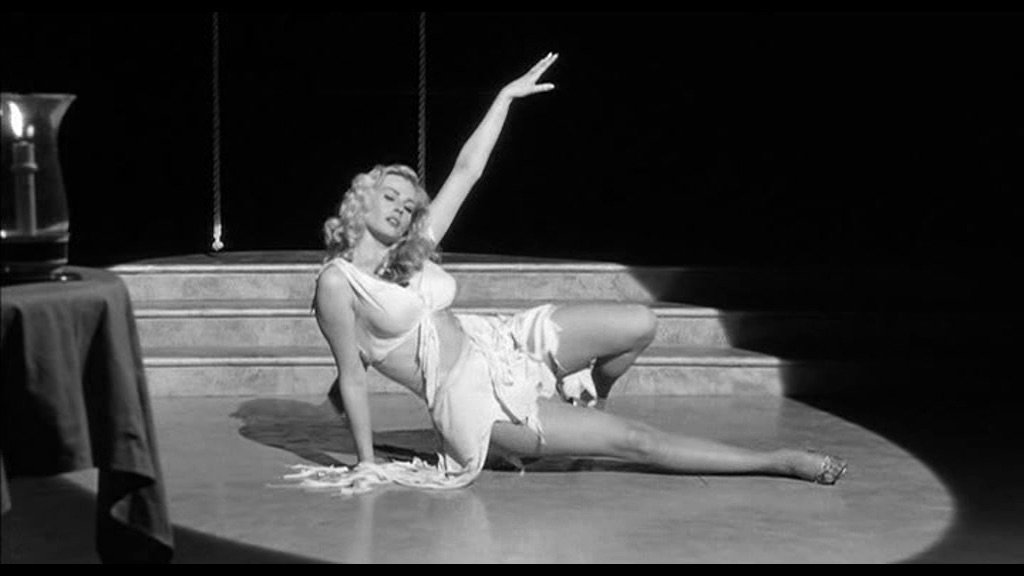
OK, so Screaming Mimi, based on eccentric cult crime/sci-fi scribe Fredric Brown's novel, is at best a hot mess of a film, more often only a lukewarm one. But you somehow can't tear your eyes away from it: it's a slow-motion car wreck with musical numbers.
Anita Ekberg, just ahead of her elevation to iconic status by Federico Fellini, is cantilevered into the role of Virginia, traumatized by a knife-wielding psycho while taking a shower (yes, the scene anticipates Psycho, and yes, it shows that the same elements can be used in a lame, ineffective way). The staff of the asylum from which the maniac escaped then feel it only their duty to take Anita into their care, where she meets the controlling, Svengali-like Dr. Greenwood, who becomes her lover and business manager when she returns to her life as an exotic dancer in the big city.

Most of the action now revolves around a nightclub tastefully named "El Madhouse," run by Gypsy Rose Lee (for realz) and featuring nightly combinations of xylophone jazz and voluptuous gyrations. Before getting to El Madhouse, the viewer may already be feeling peculiar. All the performances are subtly off, the plot seems disjointed and shapeless, the dialogue is stilted and awry. But once we get inside El Madhouse, the movie begins to act like a cocktail of disorienting drugs.
Ekberg performs her dance in chains and rags, thrashing about inelegantly, colliding with a pair of dangling ropes she's supposed to swing from. Oswald, who has clearly devoted a lot of effort to coaching his star (she's 10% less robotic than usual), here protects her by cutting to the audience a lot. They're staring, zombified, a coterie of creeps and coded lesbians. They don't seem to be enjoying themselves. But when the lights come up they suddenly spring to life and applaud wildly, an apparently Pavlovian response to illumination.
Later, they'll react in identical fashion to Gypsy's murdering of the classic Rita Hayworth number, "Put the Blame on Mame," (we're at Columbia, where life and cinematic history are cheap). No longer in the first flush of youth, and never a great beauty per se, Gypsy is a lively and likable actor, the closest thing to a human we'll meet. But she can't sing or, surprisingly, dance—at least not here.

The reason the film seems to be making itself up as it goes along is that Brown's taut mystery structure has been completely jettisoned in order to give Ekberg more screen time. We're not supposed to know that virginal Virginia and languid Yolanda Lang are the same person: easy to hide that knowledge in the book, where people don't really have appearances, only descriptions, and where the action unfolds through the eyes of a drunken reporter trying to track down a homicidal maniac. Here, we only meet the supposed hero (Phil Carey, robbed of the novel's alcoholism, reduced to blandness) about half an hour in, and we keep ditching his perspective in order to spend time with the supporting cast. Hilariously, when he tracks down the artist who sculpted the "Screaming Mimi" statuette which gives the film its name, we have to listen to a description of the film's opening scene, as if this was new information to us. For comic redundancy, this is beaten only by the bit in The Ladies' Man where Jerry Lewis has a lengthy flashback to something that happened just five minutes ago.
Oh, and that statuette? Godawful.

Burnett Guffey's cinematography is attractive, sometimes strikingly so, and the film's dismembered plotline is discombobulating enough that Oswald's vigorous if misguided direction eventually results in a very watchable experience. It's not satisfying, but it's peculiar and dopey. Two moments sum it up: a murder attempt has to be kept offscreen so that we can be surprised by a twist later, so the solution is to have a random onlooker turn to the camera and describe what he thinks just happened. And a cop stationed at Ekberg's dressing room door has to deliver a purely expository sentence about how it was really busy, but now it's quietened down. Determined to show what he can do, the bit-player attempts to instill the clause about quietening down with a gentle melancholy, a wistful, dreamy sadness. And Oswald lets the little bastard get away with it, indifferent to the fact that this is a COP, giving a REPORT to his BOSS.
Bits like that justify the whole film.

Thank you, crime scene describer!
The Forgotten is a fortnightly column by David Cairns, author of Shadowplay.